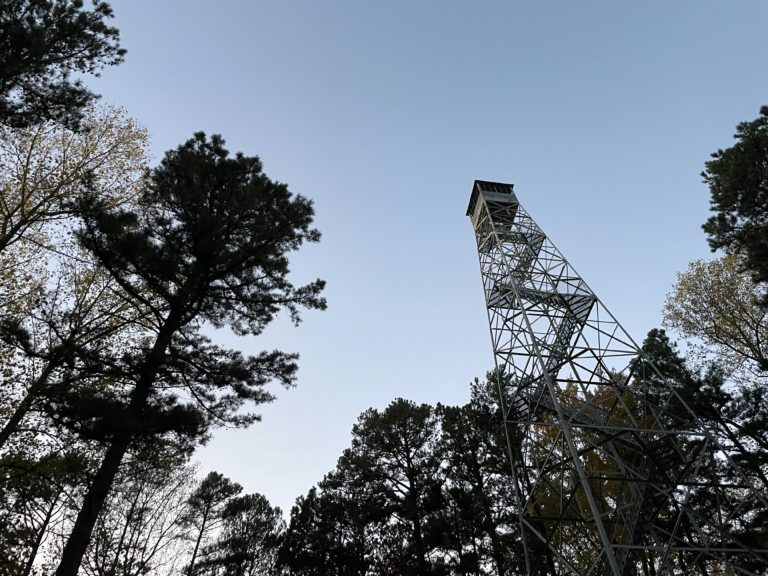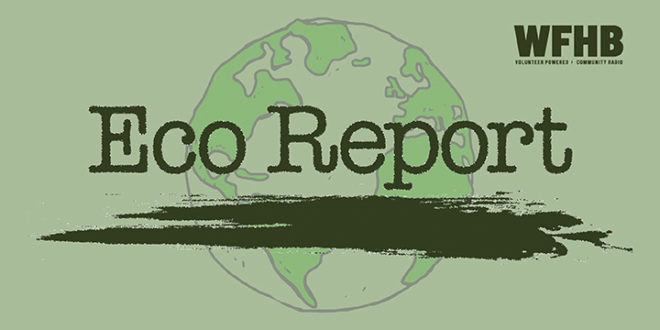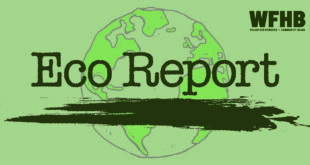Podcast: Play in new window | Download (Duration: 31:40 — 43.5MB)
Subscribe: RSS
Hello and welcome to Eco Report.
Later in the program, WFHB Correspondents Noelle Herhusky-Schneider and Kade Young look into how the Charles C. Deam Wilderness was established, in light of recent legislation introduced by Senator Mike Braun which would expand the boundaries of the wilderness area.
And now for your environmental reports:
The Indiana Capital Chronicle lists some of the issues likely to be addressed in the upcoming legislative session. The commentary was written by Sam Carpenter. Last year our power supply was in jeopardy as an extreme freeze and high winds moved in just before Christmas. Coal fired power plants did not perform well under these conditions. Just as demand grew to meet Hoosier household’s heating and cooking needs, many coal fired plants, along with gas and nuclear generation, buckled under the pressure.
Extreme frigid temps can cause coal piles to freeze limiting their accessibility. Cold temperatures can also impact the combustion process, making it harder to burn coal effectively and lead to limitations on water intake systems needed to run coal power generation. These items point to the reliability limitations of coal when it comes to keeping the lights on for Hoosiers.
According to Michael Bryson, senior vice president of system operations for PJM, the nation’s largest grid operator, the grid saw significant generation outages with about 25% of the grid’s capacity failing with Winter Storm Elliot. Coal, gas, and nuclear power were all impaired on Dec 23, 2022, while renewables, mostly made up of wind, performed well! Another challenge on that fateful day was that the transmission grid, that moves electricity hundreds of miles when required, was having trouble getting power to where it was needed. Hoosiers kept the lights on that day, but we came perilously close to a grid disaster.
Coal power generation has many liabilities, starting with being expensive. Indiana’s utilities are planning to eventually eliminate coal power generation. More economical and reliable sources of energy are available. In addition to cost concerns, coal is dirty. Burning coal is linked to health conditions including asthma, cancer, heart and lung ailments as well as environmental concerns related to acid rain and climate change. People living in counties located downwind of coal power stations have a life expectancy that is less than counties without coal plants. Coal ash or the residue left over after burning coal, is currently filling unlined pits along waterways across Indiana and is allowing toxins like mercury and arsenic to seep into our groundwater. While coal has played an important historical role in building our economy, better solutions are now available. In the interest of all Hoosiers, it is time to move away from coal.
—Norm Holy
EcoWatch reports on coral reefs have been diminished by the very high ocean temperatures of the past summer. They say next year could bring the final blow and massive coral bleaching events that disrupt reef ecosystems. Ove Hoegh-Guldberg, a marine studies professor at the University of Queensland, Australia, is predicting that coral reefs will experience dramatic bleaching. Hoegh-Guldberg and colleagues shared their predictions in a “Perspectives” piece for Science.org. Their observations are consistent with changes in reefs in Florida and the Caribbean.
Bleaching events can occur as a stress response to things such as increasing ocean temperatures and pollution, according to the National Oceanic and Atmospheric Administration.
Currently, the world is experiencing an El Niño event, which is likely to last through March 2024, which can influence warmer ocean temperatures. The current El Niño phenomenon could then be followed by a second El Niño year. As The Guardian reported, every instance where there has been a pair of El Niño years since 1997 has been followed by mass coral bleaching around the world.
It appears likely that substantial efforts to plant new corals in existing reefs may all be for naught. They could be cooked next year. Perhaps new reefs could be started in waters that were too cool before global warming.
—Norm Holy
Inside Climate Change concluded COP28 accomplished little. Only by going into overtime under the cover of a dark winter night in Dubai, climate negotiators at COP28 cooked up a weak sauce of climate half-measures that fail to adequately address the existential risk of global warming to millions of people around the globe, according to leading climate experts at the conference.
The UAE Consensus, COP28 president Sultan al-Jaber said, represents a clear step in a just transition away from fossil fuels, but the tarnished image of the United Nations Framework Convention on Climate Change, and its process requiring consensus among nations, took another big hit because 39 small island states most affected by global warming were not in the room when al-Jaber signaled acceptance during the closing speech.
COP28 still says the goal of limiting warming to 1.5 degrees Celsius over pre-industrial levels is still possible. Repeating this goal elicited an immediate response from some climate scientists, including Rob Larter, a polar researcher with the British Antarctic Survey. (quote) When you see statements like this you know you’re being lied to,(end quote) Larter wrote in a social media post. What’s been agreed certainly does not keep 1.5 Celsius in reach. Larter was one of the first scientists to highlight the abrupt and alarming decline of Antarctic sea ice this year. The vast expanses of ice at the poles function as one of the planet’s main cooling systems by reflecting a lot of incoming solar energy back into space. A permanent reduction of that surface would lead to additional heating of the atmosphere.
A huge problem with these meetings is that the final report must be agreed upon by all nations in attendance. This automatically means every report presents an overly rosy picture.
—Norm Holy
Here in the United States, it can be hard to imagine a world without single-use plastic. Even though single-use plastics are designed for our rapid use and disposal, their lifespan is just the opposite. Single-use plastic items persist indefinitely in our environment, collecting in the soil, rivers, streams, and ultimately in the ocean, endangering our food sources and entangling wildlife.
And if that’s not bad enough, single-use plastics don’t actually degrade – they simply break up into tiny microplastics that end up in the food we eat and the water we drink.
The United States is the number-one generator of plastic waste in the world, and on top of that, more than 30% of landfilled material in 2018 in the United States consisted of food waste and yard trimmings – a potent source of greenhouse gases – according to the Environmental Protection Agency. We have a lot to learn and teach that there are solutions.
—Julianna Dailey
What can you personally do to help free the United States of plastic and other trash? First, download the free Clean Swell app to track important trash data while you collect trash during your daily walks or out and about.
Second, stop littering! Even cigarette butts contain plastic that never biodegrades. Plus, animals will try to eat them. And never place trash in an overflowing trash bin; hold onto it until you can dispose of it properly.
Third, Recycle whenever possible, or better yet, use reusable items like water bottles and silverware instead of disposable ones.
Fourth, when you visit the beach or park, scan your area for five seconds to make sure you are taking everything with you. Got it all? Then take five extra trash items with you.
Fifth, you need to volunteer. Volunteer at a cleanup, especially along our parks and creeks.
Sixth, you need to be smart. Make smart consumer decisions. Don’t take that single-use plastic bag if you don’t need it. Skip the disposable straws when you can.
And last, spread the word! Talk to family, friends and legislators about the challenges facing our lands and waters and the importance of a clean, healthy earth. It’s the only one we have!
—Julianna Dailey
Feature Report:

And now, WFHB Correspondents Noelle Herhusky-Schneider and Kade Young look into how the Charles C. Deam Wilderness was established, in light of recent legislation introduced by Senator Mike Braun which would expand the boundaries of the wilderness area. We turn now to that report.
Upcoming Events:
| Enjoy the Full Cold Moon Hike at Spring Mill State Park on Saturday, December 23rd, from 7 to 7:45 pm. Join Anthony on Trail 6 for the last Full Moon of 2023 and hear stories of why it is called the Full Cold Moon. Meet at the Grissom Memorial parking lot. |
| The Whooper Wednesdays will continue at Goose Pond Fish and Wildlife Area until February 21st. Come to the Visitors Center on Wednesday, December 27th, at 8 am to walk the property and see if you can spot some of the resident birds, including the endangered Whooping Crane. Make sure to dress for the weather. |
| Learn Winter Hike Preparedness at McCormick’s Creek State Park on Saturday, December 30th, at 10:30 am. Explore the tools and habitats you can use to make your hikes more safer as you enjoy what makes winter in the woods special. Meet at the Deer Run parking lot. |
| End the 2023 Year with a Discovery Trail Hike at Brown County State Park on Sunday, December 31st, from 11 to 11:45 am. Learn about the flora, fauna, pioneer history, and the interesting geology of Brown County State Park. Meet in the Nature Center parking lot. |
Credits:
This week’s headlines were written by Norm Holy and Julianna Dailey
Today’s news feature was produced by Kade Young and Noelle Herhusky-Schneider
Julianna Dailey assembled the script which was edited by Zyro Roze.
Julianna Dailey compiled our events calendar.
Kade Young and Noelle Herhusky-Schneider produced today’s show.
Kade Young is our engineer.
 WFHB Bloomington Community Radio
WFHB Bloomington Community Radio


